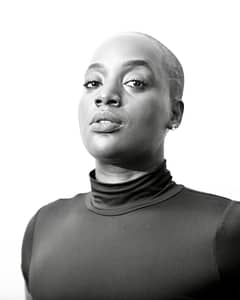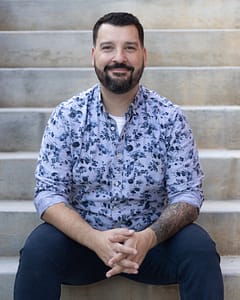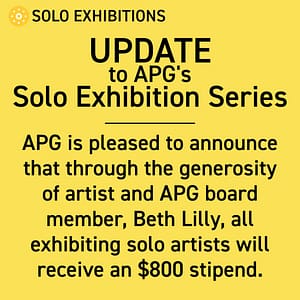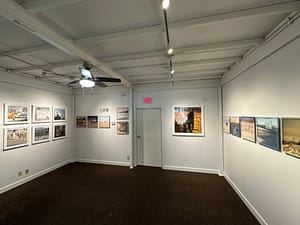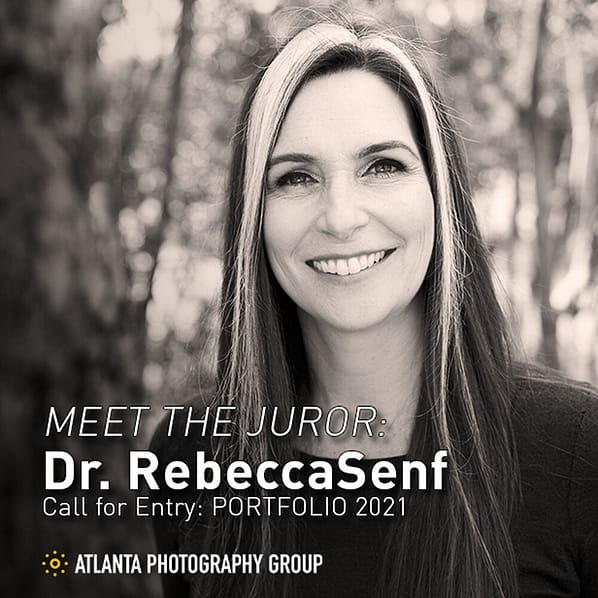
Meet Dr. Rebecca (Becky) Senf – APG’s Donna Garcia took some time with Becky to learn more about her role as the Chief Curator at the Center for Creative Photography, University of Arizona, in Tucson.
Dr. Senf is the Juror for APG’s Portfolio 2021, deadline for entry is April 19, 2021.
Becky, can you tell us a little bit about your background, and how you came to be the Chief Curator at the Center for Creative Photography, University of Arizona, in Tucson?
I grew up in Tucson, Arizona and went to the University of Arizona as an undergraduate student studying art history. That meant that I actually took classes in the Center for Creative Photography building and was able to take regular advantage of the exhibitions and library. During a photo history class in which the professor was speaking about Alfred Stieglitz and Georgia O’Keeffe and Paul and Rebecca Strand I decided that I wanted to become a photo historian. I wasn’t really sure exactly what that meant, but I was just in love with the material. I went on to graduate studies at Boston University, where I got an MA and PhD, both focused on the history of photography. I wrote my doctoral dissertation on Ansel Adams’s first decades (which was published last year as “Making a Photographer: The Early Work of Ansel Adams”) and the research for that dissertation brought me back to the Center for Creative Photography to do research in the Ansel Adams Archive. As I was finishing my doctoral degree a new position at the CCP – as the new curator for a collaboration between the CCP and the Phoenix Art Museum – opened up. I applied and returned to Tucson to work at the institution that had originally inspired my career path. After about eight years I was promoted to Chief Curator, a position I’ve held since 2016. It’s such an honor to be able to serve the Center, and build the collections, produce new knowledge through exhibitions and scholarship, and train emerging professionals. I’m so lucky to be in my dream job.
While at the Phoenix Art Museum from 2007-2015, you curated over thirty-two exhibitions, what were some of your favorites?
I’ll mention two, although there were lots of great exhibitions. One of my favorites was called “All that Glitters is Not Gold: Platinum Photography from the Center for Creative Photography” and it was on view from November 1, 2014 – March 29, 2015. The exhibition traced the use of platinum and palladium photography from its invention in the late 19th century through contemporary practice, looking at how the process was used at different moments along the way. I find that learning about platinum photography, especially close looking and understanding of the technical differences between it and gelatin silver printing, can be so valuable in appreciating photographic prints of all kinds. I’m also particularly proud of “From Above: Aerial Photography from the Center for Creative Photography” which was on view from May 4 – September 22, 2013. The Center has a surprisingly strong collection of aerial photography spanning from WWI to the 21st century, illustrating its uses in surveillance, science, photojournalism and art. The exhibition was inspired by a beautiful group of prints by Marilyn Bridges that was gifted to the CCP, which led me to investigate what other aerial photography we might have. I was delighted to find we had glass plate lantern slides of WWI trench warfare in Europe, W. Eugene Smith views of battles in the Pacific theater in WWII, Bradford Washburn’s breathtaking images of snow-covered mountain peaks, and William Garnett’s mid-century pictures made over California as some of the earliest aerial-photography-as-art. Aerial photography is both visually stunning and intellectually engaging as a visual puzzle; it makes it such a pleasurable genre of photography to work with. I’m always looking for new ways to do more with aerial photography!
What is your unique connection to the great Ansel Adams?
I began work on Ansel Adams in 2003, when I was hired as a research assistant on a major Ansel Adams exhibition for the Museum of Fine Arts, Boston. At that time, we did intensive research on the photographs in the Lane Collection, which was on long-term loan at the Museum (it’s since been gifted) for a show that opened in 2005. At the time I was a graduate student, and had submitted a dissertation prospectus on Edward Curtis and Frank Rinehart photographs of American Indians in the years around 1900. Since I would be immersed in Adams’s work for three years in preparation for the show, I changed my dissertation topic to focus on Adams, and submitted my research in 2007. Also in 2007 I became a curator at the Center for Creative Photography where Adams’s archive is held – so I’ve been able to curate five exhibitions of his work over the last 14 years. Beginning in 2017, I began to rework my dissertation for publication, and in February of 2020 “Making a Photographer: The Early Work of Ansel Adams” was co-published by Yale University Press and the Center for Creative Photography. It’s been a year of giving Zoom lectures about the book from the Art Museum of West Virginia University to the Portland (Oregon) Art Museum and from the Center for Photographic Art in Carmel, California to the International Center for Photography in New York City – and many places in between.
Tell us about some of the challenges and rewards of the many amazing photo book projects that you have worked on?
I love working on photo books! I have been the lead on four books and have contributed writing to many others, and I have consulted on the design or contents of yet others. To me the rewards are many. I think that transforming a body of work into a tangible form that can be widely distributed is such an important process for our field. It helps great photography circulate and inspire, inform, and influence others, which is the central purpose of making artwork in the first place. I also think the way in which books make projects more permanent and create a lasting legacy of the effort and process of artists is critical. But personally, I just love the creative process of taking photographic work and thinking about the very best presentation of that work in book form. How can edit, sequence, text, design, trim size, paper choice, and cover image work together to extend the photographer’s idea and intent? How can the book creation process allow the photographer to better understand the project and its potential? How can I as a curator and writer participate in conversations around content and design to facilitate a fully realized final product? I love looking at photo books, thinking about what makes them work, and helping to bring them into being. I’ve been really fortunate to do a couple of juried exhibitions of self-published photo books, and to sit on the Aperture Foundation/Paris Photo Photo book Prize jury. Photo books are alive and well and I’m always looking forward to what photographers will do with the book format next.
This year you аre serving as the esteemed Juror for the Atlanta Photography Group’s Portfolio 2021, what аre some things that you will be looking for when viewing the entries?
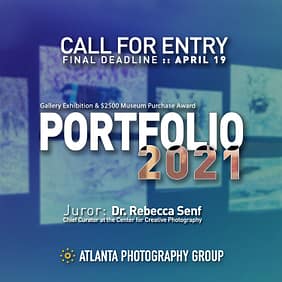
I’m always excited to see new work and to be introduced to how photographers are using this medium to express themselves,explore the world, research ideas, and share their unique perspectives. The intimacy, immediacy, and accessibility of photography make it such a powerful medium, and it continues to be increasingly central to contemporary life. I see photography as a communication art form, so I’m looking for photographs that tell me something about the maker, and their life and perspective, or about the world we all share. How the photograph comes into physical form is important to me – it doesn’t have to be a finely crafted gelatin silver print, but its presentation matters and should be in concert with the overall intent. I like seeing a concise artist statement that provides information about inspiration, intent, and goals for the work, and methodology if that’s germane; I don’t need theory, an extensive biography, or professions of passion for the medium.
What other exciting lens-based programs or exhibitions аre you working on currently?
I’m in the research process for a couple of long-term exhibition projects, including showing the work of a fashion photographer of the first part of the 20th century, an Arizona artist in the last part of the 20th century, and thinking about vernacular photography. Right now, however, I’m most excited about a research initiative the Center for Creative Photography has undertaken to better understand African American photography of the last 100 years.
Which artists, writers, academics, curators, and other creative thinkers have influenced you?
This is a surprisingly difficult question to answer. Although there are certainly artists, curators, and writers I could list whose work has inspired me, I don’t feel that there are any names that logically reflect on the work I do. For me a constant supply of new information including poetry, fiction, non-fiction, podcasts, conversations with friends and colleagues (including my CCP co-workers and artists within that group), travel, television, music, movies, and professional conferences all meld into my thinking about my work. I feel like I’m a sponge, constantly absorbing things, critiquing them, and reassembling them. Recently I’ve been listening to Dolly Parton’s America and Samin Nosrat and Hrishikesh Hirway’s Home Cooking podcasts, watching (binging) Schitt’s Creek, reading British author Matt Haig, listening to Dua Lipa’s Future Nostalgia album, and doing Zoom happy hours with close curatorial colleagues and lots of artist friends. It’s been hard to be without art in person these last 12 months but I’ve pivoted towards new sources; but it will be so good to be with real objects again, hopefully soon!
Juror – Dr. Rebecca Senf
Dr. Rebecca Senf is Chief Curator at the Center for Creative Photography at the University of Arizona, in Tucson. Her B.A. in Art History is from the University of Arizona; her M.A. and Ph.D. were awarded by Boston University. In 2012, her book Reconstructing the View: The Grand Canyon Photographs of Mark Klett and Byron Wolfe was released by University of California Press; in 2017, her book To Be Thirteen, showcasing the work of Betsy Schneider, was published by Radius Press and Phoenix Art Museum. Senf is an Ansel Adams scholar, and recently published a book on Ansel Adams’s early years, called Making a Photographer, co-published by the CCP and Yale University Press.

